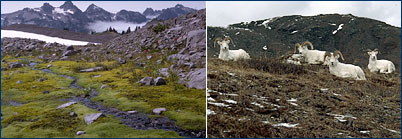
Encyclopedia Britannica (English and Spanish versions)
Great background knowledge written by authorities in each field.
https://school.eb.com/levels
https://escolar.eb.com/
https://moderna.eb.com/levels/academica
From school-none needed.
From home:
Username: asmlibrary
Science Reference Center (Ebsco)
Science Reference Center contains full text for hundreds of science encyclopedias, reference books, periodicals, and other sources. (Applied Sciences, Earth Sciences, Life Sciences, Physical Sciences, Scientists, and Space Sciences & Astronomy)
http://search.ebscohost.com
Username: asmschol
ImageQuest
Thousands of royalty-free images, all subject areas. Citations included in downloads.
https://quest.eb.com/
Username: asmlibrary
Your teacher has the passwords on her Google Classroom site.
Tundra is flat and cold with low plants like grass and moss that only grow during the short summer. A thick layer of ice lies just below the shallow soil (permafrost) all year around, and trees cannot penetrate it to anchor their roots. Many birds visit the tundra in the summer to nest, but most escape the winter by migrating to warmer areas. Mice and other small mammals stay active during the winter in protected tunnels under the snow.
Tundra is the coldest of all the biomes. Tundra comes from the Finnish word tunturi, meaning treeless plain. It is noted for its frost-molded landscapes, extremely low temperatures, little precipitation, poor nutrients, and short growing seasons. Dead organic material functions as a nutrient pool. The two major nutrients are nitrogen and phosphorus. Nitrogen is created by biological fixation, and phosphorus is created by precipitation.
Characteristics of tundra include:
Tundra is separated into two types:
https://ucmp.berkeley.edu/exhibits/biomes/tundra.php

Several good websites with lists of animals who live in the tundra areas:

From left: alpine tundra in Mt. Rainier National Park, Washington; Dall Sheep in the Arctic National Wildlife Refuge, Alaska.
Alpine tundra is located on mountains throughout the world at high altitude where trees cannot grow. The growing season is approximately 180 days. The nighttime temperature is usually below freezing. Unlike the arctic tundra, the soil in the alpine is well drained. The plants are very similar to those of the arctic ones and include:
Animals living in the alpine tundra are also well adapted:
https://ucmp.berkeley.edu/exhibits/biomes/tundra.php

From left: tundra near Churchill, Manitoba, Canada; tundra in the Arctic National Wildlife Refuge, Alaska.
Arctic tundra is located in the northern hemisphere, encircling the north pole and extending south to the coniferous forests of the taiga. The arctic is known for its cold, desert-like conditions. The growing season ranges from 50 to 60 days. The average winter temperature is -34° C (-30° F), but the average summer temperature is 3-12° C (37-54° F) which enables this biome to sustain life. Rainfall may vary in different regions of the arctic. Yearly precipitation, including melting snow, is 15 to 25 cm (6 to 10 inches). Soil is formed slowly. A layer of permanently frozen subsoil called permafrost exists, consisting mostly of gravel and finer material. When water saturates the upper surface, bogs and ponds may form, providing moisture for plants. There are no deep root systems in the vegetation of the arctic tundra, however, there are still a wide variety of plants that are able to resist the cold climate. There are about 1,700 kinds of plants in the arctic and subarctic, and these include:
All of the plants are adapted to sweeping winds and disturbances of the soil. Plants are short and group together to resist the cold temperatures and are protected by the snow during the winter. They can carry out photosynthesis at low temperatures and low light intensities. The growing seasons are short and most plants reproduce by budding and division rather than sexually by flowering. The fauna in the arctic is also diverse:
Animals are adapted to handle long, cold winters and to breed and raise young quickly in the summer. Animals such as mammals and birds also have additional insulation from fat. Many animals hibernate during the winter because food is not abundant. Another alternative is to migrate south in the winter, like birds do. Reptiles and amphibians are few or absent because of the extremely cold temperatures. Because of constant immigration and emigration, the population continually oscillates.
https://ucmp.berkeley.edu/exhibits/biomes/tundra.php